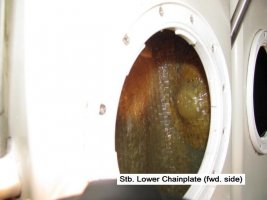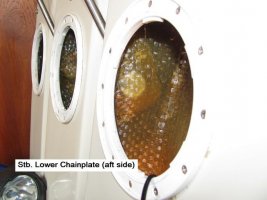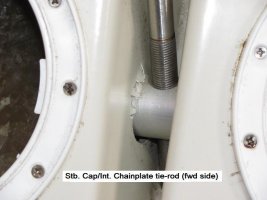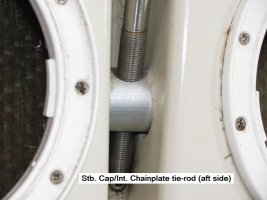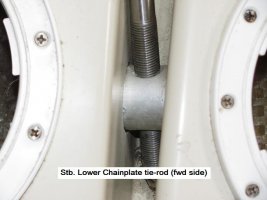Frank Langer
1984 Ericson 30+, Nanaimo, BC
Hi,
I am beginning to talk with sail lofts about a new mainsail for our 1984 E30+ and one issue has come up repeatedly causing real puzzlement: mast rake and mast bend, and lack thereof on the E30+.
I have tuned our rig as recommended in the Ericson Rig Tuning Guide for the E30+ (a one page document available in the downloads for The e30s on this site), and the boat generally sails well--up to 7.8 knots in 15 - 17 knot wind. The helm feels balanced, the boat tracks nicely and only experiences significant weather helm in gusts above 25 knots when I am overpowered. :0
The mast is straight, does not fall off to leeward when sailing upwind in about 18 - 20 knots, lee shrouds are not slack, and as best I can determine, shrouds are tensioned to about 12% of breaking strength (as recommended I think by Brion Toss/Rigger's Apprentice); cap shrouds and lowers are a bit tighter than the intermediates. So all seems good--except that this boat being a fractional rig, it should have mast rake and pre-bend in the mast, and the sail lofts are very surprised when I tell them that it seems to have been designed to sail without rake and pre-bend (according to the Ericson tuning guide for this boat).
When I apply the manual back stay adjuster, the boat will flatten a bit if heeled a bit too much, but I can't detect noticeable mast bend even then. I have adjusted the headstay length on our Harken furler to it's maximum and tightened the turnbuckles on the backstay to their maximum to shorten the backstay a bit, so I don't have any more room there to create mast rake without replacing the headstay and backstay. So it seems that the rigger made the stays of a length to prevent rake/prebend.
So my question: Was the E30+ really designed to sail without mast rake and mast bend? If she sails well without, should I leave well enough alone, or am I missing something here? Any comments, explanations, advice from the experts or from other owners of the E30+ would be very welcome.
Thanks,
Frank
I am beginning to talk with sail lofts about a new mainsail for our 1984 E30+ and one issue has come up repeatedly causing real puzzlement: mast rake and mast bend, and lack thereof on the E30+.
I have tuned our rig as recommended in the Ericson Rig Tuning Guide for the E30+ (a one page document available in the downloads for The e30s on this site), and the boat generally sails well--up to 7.8 knots in 15 - 17 knot wind. The helm feels balanced, the boat tracks nicely and only experiences significant weather helm in gusts above 25 knots when I am overpowered. :0
The mast is straight, does not fall off to leeward when sailing upwind in about 18 - 20 knots, lee shrouds are not slack, and as best I can determine, shrouds are tensioned to about 12% of breaking strength (as recommended I think by Brion Toss/Rigger's Apprentice); cap shrouds and lowers are a bit tighter than the intermediates. So all seems good--except that this boat being a fractional rig, it should have mast rake and pre-bend in the mast, and the sail lofts are very surprised when I tell them that it seems to have been designed to sail without rake and pre-bend (according to the Ericson tuning guide for this boat).
When I apply the manual back stay adjuster, the boat will flatten a bit if heeled a bit too much, but I can't detect noticeable mast bend even then. I have adjusted the headstay length on our Harken furler to it's maximum and tightened the turnbuckles on the backstay to their maximum to shorten the backstay a bit, so I don't have any more room there to create mast rake without replacing the headstay and backstay. So it seems that the rigger made the stays of a length to prevent rake/prebend.
So my question: Was the E30+ really designed to sail without mast rake and mast bend? If she sails well without, should I leave well enough alone, or am I missing something here? Any comments, explanations, advice from the experts or from other owners of the E30+ would be very welcome.
Thanks,
Frank

